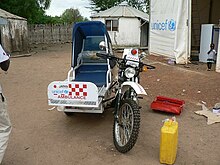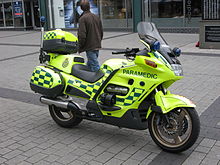Motorcycle ambulance: Difference between revisions
m Added Kenya and included references to IFRTD and DFID websites |
|||
| Line 5: | Line 5: | ||
===Japan=== |
===Japan=== |
||
Some Japanese fire departments use off-road motorcycles as emergency vehicles. They are useful for negotiating the small streets and heavy traffic in some areas. They would likely work in teams of two or three motorcycles. One of the motorcycles carries a [[first aid kit]] and a trained [[Certified first responder|first responder]]. The other motorcycles carry fire fighting and rescue equipment.{{Citation needed|date=October 2009}} |
Some Japanese fire departments use off-road motorcycles as emergency vehicles. They are useful for negotiating the small streets and heavy traffic in some areas. They would likely work in teams of two or three motorcycles. One of the motorcycles carries a [[first aid kit]] and a trained [[Certified first responder|first responder]]. The other motorcycles carry fire fighting and rescue equipment.{{Citation needed|date=October 2009}} |
||
==Kenya== |
|||
As part of [[DfID]]'s wider £50 million country programme (2009), they are putting in place among other things a new motorbike ambulance service. The Magunga's Health Centre now operates a motorbike ambulance service.<ref>http://www.ifrtd.org/new/news/full.php</ref><ref>http://webarchive.nationalarchives.gov.uk/+/http://www.dfid.gov.uk/news/files/kenya-mothers-day.asp</ref> |
|||
===Malawi and Sudan=== |
===Malawi and Sudan=== |
||
Revision as of 09:53, 2 November 2009

Motorcycle ambulances are a type of emergency vehicle able to respond to a medical emergency much faster than a car or van in heavy traffic.[citation needed] A motorcycle ambulance may be equipped with a trailer or sidecar for transporting patients.
Worldwide motorcycle ambulances
Japan
Some Japanese fire departments use off-road motorcycles as emergency vehicles. They are useful for negotiating the small streets and heavy traffic in some areas. They would likely work in teams of two or three motorcycles. One of the motorcycles carries a first aid kit and a trained first responder. The other motorcycles carry fire fighting and rescue equipment.[citation needed]
Kenya
As part of DfID's wider £50 million country programme (2009), they are putting in place among other things a new motorbike ambulance service. The Magunga's Health Centre now operates a motorbike ambulance service.[1][2]
Malawi and Sudan

They have been used in remote rural areas in Malawi and Sudan as a means to improve access to health care facilities for women in labor or needing prenatal care. Lightweight off-road motorcycles, equipped with a sidecar holding a stretcher for the patient, have been found to be an efficient supplement, but not replacement for, 4-wheel drive SUV ambulances. Purchase prices and operating costs have been found to be a fraction of a four wheeled vehicle, and the sidecar rigs have been found to be less likely to be misused by diverting them for non-healthcare purposes. The lighter sidecar rigs are better able to cope with poor roads and areas that become impassible to heavier cars and trucks during the rainy season. Disadvantages include the reluctance of drivers to travel at night in some cases, and the inability to carry more than one patient at a time.[3][4]
The report concluded that:
Motorcycle ambulances reduce the delay in referring women with obstetric complications from remote rural health centers to the district hospital, particularly under circumstances where health centers have no access to other transport or means of communication to call for an ambulance. They are also a relatively cheap and effective option for referral of patients in developing countries, particularly in rural areas with little or no public transport. Nineteen motorcycle ambulances can be bought for the price of one Toyota Land Cruiser car ambulance. Operating costs compare in a similar way. Motorcycle ambulances also potentially help reduce costs for women and their families to access EmOC, although this was not the subject of this study.[5]
United Kingdom

Motorcycles are used as rapid response vehicles by emergency medical services in the United Kingdom.[6][7]
Manufacturers
Honda motorcycles are common models used in many countries and departments.
A number of manufacturers continued to produce sidecars for many popular motorcycles and scooters. Active motorcycle ambulance manufactures include The Ranger Production Company.[8][9]
History


Motorcycle ambulances were used during World War I by the British, French and Americans. At the time the advantages of light weight, speed, and mobility over larger vehicles was cited as the motive for the use of sidedcar rigs in this role. The US version had two stretchers arranged one on top of the other.[10][11][12] The US version had two stretchers arranged one on top of the other.[13] The French ambulance used a sidecar that held a single patient, who could either lie down or sit up.[14]
The British Red Cross Society used an 8 bhp (6.0 kW) NUT motorcycle with a double decker sidecar as well. During testing it needed only a 9 ft (2.7 m) turning area, versus 35 ft (11 m) for a motor car ambulance, and had a lower fuel consumption of 55–65 mpg‑US (4.3–3.6 L/100 km), compared with 12–17 mpg‑US (20–14 L/100 km) for car ambulances. Due to lighter weight they were said to be less likely to get stuck and could be pushed out more easily than a large vehicle.[15]
Sidecar ambulances were used in Redondo Beach, California in 1915, stationed at a bath house at a beach resort to reach drowning victims quickly. Prior to using the motorcycle, life guards had to run or row up to several miles along the beach to respond to calls.[16] The Knightsbright Animal Hospital and Institute, London, was using a sidecar ambulance to transport dogs in 1912, and this mode was still in use in 1937 by the Maryland Humane Society.[17][18]

See also
- Ambulance
- Riders for Health – a charity which provides motorcycle ambulances in Africa
References
- ^ http://www.ifrtd.org/new/news/full.php
- ^ http://webarchive.nationalarchives.gov.uk/+/http://www.dfid.gov.uk/news/files/kenya-mothers-day.asp
- ^ IRIN (1 April 2009), SUDAN: Biking for safer childbirth; A motorbike ambulance is test driven in South Sudan at the launch of a pilot project aimed to cut maternal mortality, Integrated Regional Information Networks (UN Office for the Coordination of Humanitarian Affairs)
- ^ Kelly, Liz; Ford (13 May 2009), "Could motorbikes cut deaths in childbirth in Africa?", The Guardian
- ^ Dzimadzi, Chris; Lungu, Kingsley; Ratsma, Esther Y. (2008), "Motorcycle ambulances for referral of obstetric emergencies in rural Malawi: Do they reduce delay and what do they cost?" (pdf), International Journal of Gynecology & Obstetrics, 102 (2), International Federation of Gynecology and Obstetrics: 191–197, doi:10.1016
{{citation}}:|first1=missing|last1=(help);|first5=missing|last5=(help); Check|doi=value (help); Missing pipe in:|first1=(help); Missing pipe in:|first5=(help)CS1 maint: numeric names: authors list (link) - ^ "Motorcycle responder". London Ambulance Service. Retrieved 1 November 2009.
- ^ "Motorcycle Paramedics". Inside Out. BBC. February 2008. Retrieved 1 November 2009.
- ^ http://kambia.org.uk/new/what-we-do/our-projects/transportation-for-pregnant-women/
- ^ http://www.southafrica.info/business/trends/innovations/eranger.htm
- ^ Whitney, Caspar; Britt, Albert (October 1916-March 1917), Outing: sport, adventure, travel, fiction, vol. 69, Outing Publishing Company, p. 490
{{citation}}: Check date values in:|date=(help) - ^ Hopkins, Albert (1915), The Scientific American war book: the mechanism and technique of warfare, Scientific American, pp. 101–102
- ^ "Chauffeur and Nurse, Too, is the Ambulance Driver", The Popular Science Monthly, vol. 93
- ^ "Motorcycle Ambulance Has New Features", Popular mechanics magazine, vol. 30, Popular Mechanics, p. 165, 1918
{{citation}}: Unknown parameter|editorfirst=ignored (|editor-first=suggested) (help); Unknown parameter|editorlast=ignored (|editor-last=suggested) (help) - ^ "Chauffeur and Nurse, Too, is the Ambulance Driver", The Popular Science, vol. 93, no. 2, August 1918
{{citation}}: Text "ISSN 0161-7370" ignored (help) - ^ Buist, H. Massac (January 15, 1916), "Medical Arrangements of the Expeditionary Force", Motor Ambulances for War Service (Adobe PDF), p. 133
- ^ "Life Saving Motorcycle", Safety engineering, vol. 30, A. H. Best. Co., p. 270, 1915
- ^ "Motor Ambulance for Dogs", Popular Mechanics, vol. 18, no. 1–6, p. 570, July–December 1912
{{citation}}: Cite has empty unknown parameter:|1=(help); Unknown parameter|editorfirst=ignored (|editor-first=suggested) (help); Unknown parameter|editorlast=ignored (|editor-last=suggested) (help)CS1 maint: date format (link) - ^ "Sick Dogs and Cats Ride Motorcycle Ambulance", Popular Mechanics, vol. 67, no. 2, p. 201, February 1937, ISSN 0032-4558
